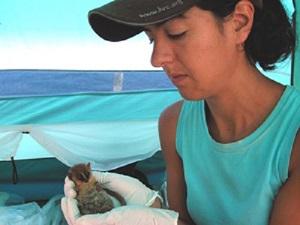Marina Beatriz Blanco
The goal of this project is to ascertain the effects of forest fragmentation and altitude on the reproductive biology and population dynamics of Microcebus rufus, the brown mouse lemur and Cheirogaleus spp. in the eastern rain forests of Madagascar.

Tsinjoarivo fragment mouse lemur.
The goal of this project is to ascertain the effects of forest fragmentation and altitude on the reproductive biology and population dynamics of Microcebus rufus, the brown mouse lemur and Cheirogaleus spp. in the eastern rain forests of Madagascar.

Research areas will include the primary, high-altitude forests at Tsinjoarivo, and two additional habitats that can be considered, in different ways, “marginal”:
(1) the fragmented forests only several kilometers away from the pristine forests at Tsinjoarivo;
(2) a secondary, mid-altitude forest at the Ranomafana National Park. Sampling areas at Tsinjoarivo will be determined via census walks within randomly-selected large and small fragments.
Capture/mark/recapture techniques will be employed at all sampling sites during the reproductive season. This project will examine the ecological correlates of variation in the timing of estrus, manifestations of polyestry, and the reproductive health (including the frequency of abortion) of Microcebus and Cheirogaleus in these habitats, as well as their density and distribution. Given the rate at which forests are becoming fragmented today and primary vegetation is being replaced by secondary, understanding the dynamics of lemur reproduction in such habitats is critical if we are to ensure their long-term survival. By examining the reproductive biology of cheirogaleids in habitats in which they are most vulnerable, this project should yield data critical to their conservation.
Indeed, it is quite possible that this project will yield even more important and serendipitous benefits to the conservation of cheirogaleids, because there is good reason to believe that new cheirogaleid species will be found at Tsinjoarivo. Nobody has previously studied the nocturnal primates at Tsinjoarivo in any detail, and trapping is essential to verifying specific identity. Because Tsinjoarivo is effectively a high-altitude “island” surrounded by lower-altitude forests, and isolated from the nearest high-altitude peaks by the Onive River to the south and the Mangoro River to the east, speciation is not unexpected. Furthermore, it is possible that Allocebus lives at Tsinjoarivo; without close examination, it is impossible to distinguish this species from Microcebus. At a minimum, this project will impact our understanding of the tolerance of rain forest cheirogaleids to environmental variation, and result in a better understanding of aspects of the developmental, life history, and reproductive profiles of various cheirogaleid (mouse and dwarf lemur) species in Madagascar within the contexts of the habitats in which they live.